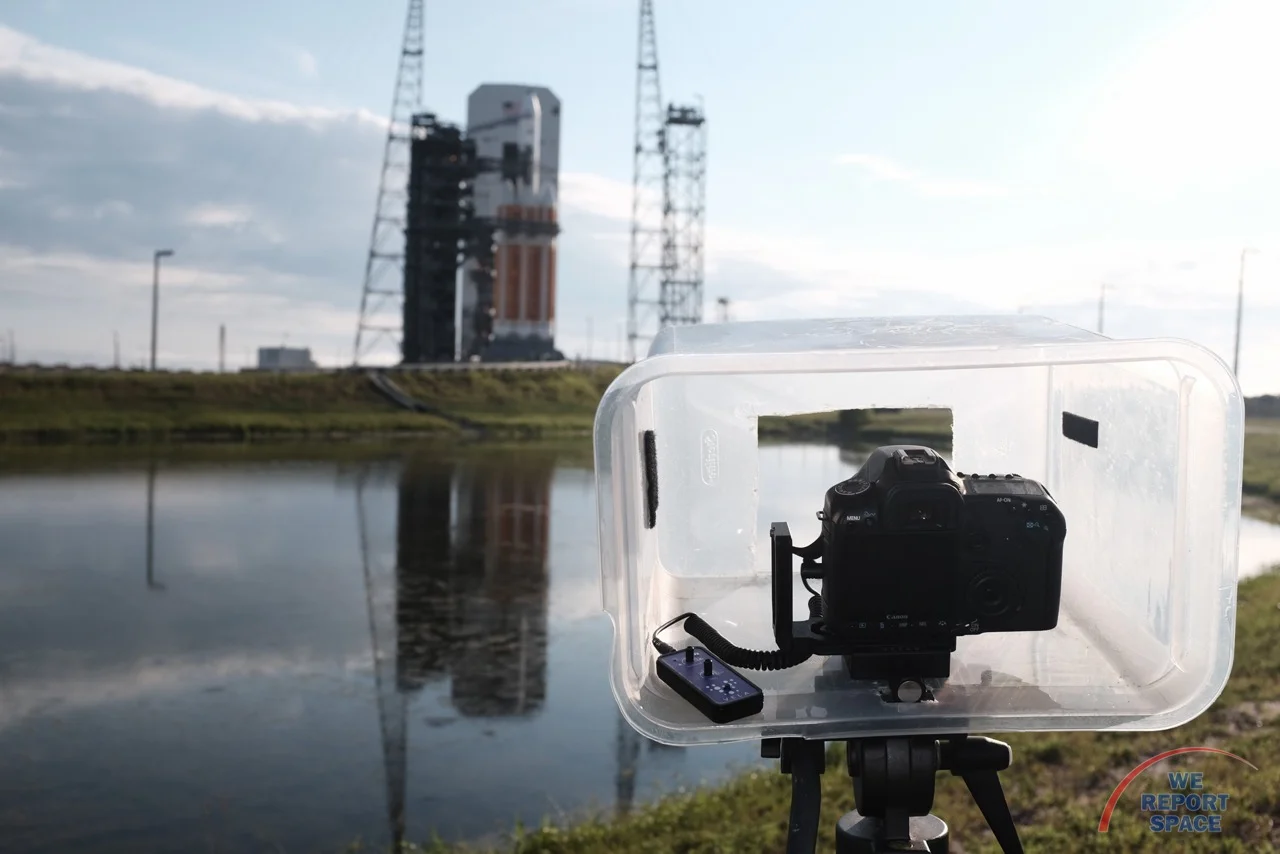On Saturday, June 11th, 2016 at 1:51pm Eastern Daylight Time, nothing happened. At least, if you ask the National Reconnaissance Office, that's what they'll probably tell you. If they're feeling particularly charitable, they might go so far as to confirm that a mission, named NROL-37, was launched in Florida.
NROL-37 Liftoff at Cape Canaveral Air Force Station. Photo credit: Dawn & Jared Haworth
Thankfully, the NRO's mission partner, United Launch Alliance, is slightly more forthcoming, allowing members of the press the opportunity to observe the launch from just 1.6 miles distant, after first allowing those same photojournalists the opportunity to place sound-activated cameras at the launchpad to capture up-close views of the liftoff.
For every launch, photographers only get one shot at capturing images of the launch; if the camera fails to fire, or if the trigger malfunctions, we can't very well ask NASA, ULA, SpaceX or Orbital ATK to bring the rocket back and let us try again. In the case of NROL-37, that went double, as the mission's parameters dictated the use of the Delta IV Heavy, a rare sight on Florida's Space Coast.
The Delta IV Heavy is the highest-capacity rocket currently operating, and consists of three Delta IV cores fastened together into one heavy-lift rocket. To date, the Delta IV Heavy has only flown 9 times since its debut in 2004, sometimes going 2-3 years between flights. The last most recent flight of the Delta IV Heavy was to loft NASA's prototype crew capsule, the Orion Multi-Purpose Crew Vehicle on its debut, uncrewed test flight in 2014.
Orion EFT-1 Launch, December 5, 2015. Photo credit: Jared Haworth
In order to capture the launch of the world's highest capacity rocket, we needed a sound trigger that was going to get the job done without missing a shot. For We Report Space photographers myself, Michael Seeley and Bill Jelen, since December 2015, that trigger has been the Vela Pop.
But let's back up for just a moment and talk about sound-activated launch photography.
I've had the benefit of covering most Florida launches since early 2014. At that time, I was fortunate enough to be accepted into the NASA Social program, NASA's groundbreaking social media outreach initiative, in which everyday people, who happen to be active on social media, are given legitimate press credentials to come and cover a launch. I had the opportunity to cover the SpaceX CRS-3 resupply mission to the International Space Station as part of that program. At the time, I met a number of photojournalists, and was introduced to the incredible world of launch remote camera photography.
The photographers covering launches at Cape Canaveral Air Foce Station use a variety of methods to wake and trigger their cameras in time for launch. I've seen $300 lightning triggers, converted hot water heater timers wired to a stack of AA batteries and a knock sensor, and everything in between. My background is software development, rather than hardware design, so my own home-built attempt featured an Arduino Fio microcontroller, 5v reed relay, and a small condenser mic simply measuring sound pressure. While my homebrew solution served me well, it was unwieldy, consisting of loose wires, exposed circuitry, and a fiddly sensitivity knob that required me to carry a nail file with me to make adjustments.
After the Morelos-3 launch in October 2015, solid rocket motor exhaust coated my camera & trigger, corroding the traces on the exposed printed circuit board and rendering the entire device inoperable.
Earlier that year, I'd read about the upcoming Vela Pop trigger, and couldn't wait to get my hands on one to try it out. Since the Pop was designed primarily as a trigger for the Vela One flash, it had a couple of quirks that made its use triggering a digital SLR camera a little tricky, but Matt was more than willing to work with me to identify a way in which the Pop could be modified to support launch photography. One of our requirements is to continually trigger the camera during sustained noise, as the rocket doesn't emit a single "blurt" on its way to space, but instead trails on for a minute-long deafening roar. Matt's modifications enabled us to shoot at a continuous 3 frames per second, for as long as the trigger continued to detect sound above its threshold.
The first trial run for our Vela Pop triggers was during SpaceX's historic Orbcomm OG2-M2 mission, where the Falcon 9 rocket was launched, deployed its payload, then successfully returned to land at Landing Zone 1, Cape Canaveral Air Force Station. The Vela Pop with the upgraded firmware performed perfectly, capturing a series of close up photos of the rocket engine as the launch vehicle sped off the pad.
SpaceX Falcon 9 Orbcomm OG2-M2 Launch, December 21, 2015. Photo credit: Jared Haworth
At this time, the We Report Space team collectively owns six Vela Pop triggers, and they're the only triggers we use on our DSLR remote cameras (in fact, while I was writing this article, two of them were deployed in the field at Space Launch Complex 40 to capture today's SpaceX Eutelsat / ABS launch -- total success for photos, even if the first stage of the rocket didn't survive the landing.
So, back to the NROL-37 mission. The Vela Pop is a tough, fast trigger, surviving the extra heat and blast that the Delta IV Heavy could throw at it. For the cameras we placed, the rocket was only in frame for roughly 14 seconds. The Vela Pop started shooting fast enough to catch the initial hydrogen burn-off during engine ignition, and kept shooting until long after the rocket had left the frame, gathering us about 30 photos in the span of those 14 seconds (the 3fps speed was hampered by the in-camera RAW buffer on the Canon 40D cameras we use, after about 20 shots, the buffer is expended and the camera slows down).
Startled birds at the NROL-37 launch. Photo credit: Jared Haworth
From 2,000 feet away, we captured the view of startled birds fleeing the launchpad. At 1,000 feet away, we got the hydrogen fireball, the full liftoff cycle, and a great shot of the rocket rising above the exhaust cloud before leaving the frame, and from 600 feet away, we captured a stunning close-up shot of all three Aeroject Rocketdyne RS-68A main engines firing at full thrust.
RS-68A engines. Photo credit: Jared Haworth
One of the best things about the Vela Pop is the battery life. With almost 15 days of run-time, the triggers we placed on Wednesday morning were all still firing on Saturday afternoon when the rocket lifted off... other triggers may only be good for a single day attempt, but the Vela Pop has enough capacity to cover multiple launch windows. By turning the trigger off between launches, we've extended the battery life up to three months before requiring replacement.
Above, I mentioned off-the-shelf triggers costing in the neighborhood of $300. My own home-made solutions ran about $60-70 in parts each, not including the otherwise billable hours I spent writing and debugging the software. The Vela Pop costs about $45, and at that pricepoint, is a fully executed project, not a clumsy prototype (as my homemade triggers were). For that price, you can field six of them, versus just one off the shelf sound & lightning trigger.
It's safe to say that we're all big fans of the Vela Pop, and will continue to rely on it for every launch we photograph in the future.
Jared Haworth is the Senior Photo Editor for We Report Space and has recently authored a book featuring photos from the prior two years of Florida rocket launches (available from Amazon as well as the We Report Space online shop). For more launch coverage, follow We Report Space on Facebook, Instagram and Twitter.








